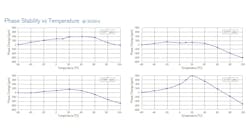Cable Assemblies for Next-Gen mmWave Phased Arrays
This video appeared on Microwaves & RF and has been published here with permission.
Check out more TechXchange Talks videos.
RF/microwave engineers know this better than just about anyone (except for, perhaps, RF/microwave test engineers): Not all cable assemblies are created equal. An extremely critical facet of cable assemblies in the 5G era is their phase and amplitude stability over temperature variations (see figure) and with respect to flexure.
That's why Junkosha put so much energy into its MWX7 Series cable assemblies, which exploit the company's own dielectric ePTFE tape-wrapping technology to deliver both inter- and intra-batch performance consistency.
Both characterization and deployment of 5G large-scale, phased-array radar and MIMO systems count on the stability of RF interconnects like the MWX7 Series assemblies. Consider such radar installations and their criticality in detection of real-time defense threats.
These radar systems will often be deployed in locations that experience temperature extremes, both high and low. Therefore, the interconnects' stability in the face of such temperature shifts needs to be rock solid so that there's no lag in response times.
In this video, Junkosha's president and CEO, Joe Rowan, discusses the company's MWX7 Series cable assemblies, noting Junkosha's long-standing heritage in both mmWave technology and in creation/manipulation of ePTFE dielectric material. Both of these attributes are key to the development of the MWX7 Series cable assemblies.
Note also that Junkosha will be highlighting its MWX7 Series cables at the upcoming European Microwave Week, which is taking place this week in London at the ExCel London Exhibition and Conference Center.

